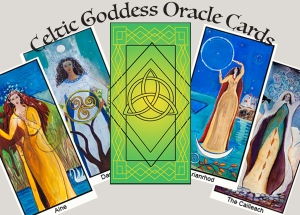 Blodeuwedd, also known as the Ninefold Goddess of the Western Isles of Paradise, was a Goddess like no other in the manner of her birth. She is one of the main figures in the Mabinogion, the Welsh cycle of stories of the early Celtic Goddesses and Gods. But to understand Blodeuwedd, her short life, her actions, and her death we must look back to the story of Arianrhod, Celtic Sky Goddess.
Blodeuwedd, also known as the Ninefold Goddess of the Western Isles of Paradise, was a Goddess like no other in the manner of her birth. She is one of the main figures in the Mabinogion, the Welsh cycle of stories of the early Celtic Goddesses and Gods. But to understand Blodeuwedd, her short life, her actions, and her death we must look back to the story of Arianrhod, Celtic Sky Goddess.

Both Arianrhod and Blodeuwedd, viewed through the patriarchal lenses, get bad raps for their actions. Arianrhod, the most powerful child of the great Mother Goddess, Don, was a Virgin Goddess in the ancient meaning of the word virgin – a woman who is complete unto herself; a woman who needs no protection from a man; a woman who bestowed her sexual favors where and when she chose.
But Arianrhod was deceived by her brother, Gwydion, a powerful magician and heir to the kingship as the eldest son of Don. In those days the kingship was passed on through the mother line, through the children of the king’s sister. Children were seen as gifts from the Goddess given to humanity through the bodies of women.
Yet times changed. People began to speak of a new concept – fatherhood. With that concept came the masculine need for female chastity before marriage. Arianrhod became enamored by the glamour of this fashion, yet with no intention or desire of practicing chastity.
Arianrhod’s uncle, the magician King Math, was under a strange taboo which required him to keep his feet in the lap of a virgin whenever he was not actively engaged in battle. Gwydion, suggested Arianrhod for this role. Yet during the time he had to tell her of that role, he hoped to convince her to marry him instead, thus ensuring his own sons would be in line for kingship. Ariahrhod enjoyed Gwydion’s company but she had no desire to marry. She longed for the excitement of court. She decided to accept King Math’s offer
Gwydion, using magic and trickery forced Arianrhod to conceive his child. To prove her virginity she had to step across a magical rod. While doing that, she fell victim of Gwydion’s magic and immediately gave birth to two twin boys. The first, who Math named Dylan, fled to the sea and swam away. The second boy, unnoticed by all present, was scooped up by Gwydion and raised in a magic forest.
And this is where the need for Blodeuwedd enters the tale. When Arianrhod  learned of Gwydion’s betrayal, she laid three curses on the boy. She denied the child a name or the right to bear arms – the right of Welsh mothers – which gives a clear indication of the ancient power of women. But Gwydion tricked Arianrhod into granting them. The third curse, that “the boy shall have no wife of the race that is now on the earth,” was more difficult to break.
learned of Gwydion’s betrayal, she laid three curses on the boy. She denied the child a name or the right to bear arms – the right of Welsh mothers – which gives a clear indication of the ancient power of women. But Gwydion tricked Arianrhod into granting them. The third curse, that “the boy shall have no wife of the race that is now on the earth,” was more difficult to break.
Marriage was essential because to become king Llew had to marry a woman, a Goddess, a representative of the land. Finally Gwydion, with Math’s help, created a woman out of flowers to be Llew’s wife. What better representation of the land than a woman made of flowers of primrose, bean, broom, meadowsweet, burdock, nettle, oak, hawthorn and chestnut. She was named, Blodeuwedd, meaning “Flower Face.” She was the earth in full bloom, making Llew’s sovereignty legitimate.
So Blodeuwedd was born a full grown woman, beautiful and passive. She was made to be Llew’s wife. It was expected that she would accept this role without question. And so she did… at first. Until the day when she was alone with her ladies and first laid eyes on Gronw, a handsome huntsman. Her heart quickened and the first desire of her own awakened. Grown’s heart quickened also and their fate was sealed.
Now she could no longer accept the destiny that others had laid on her. Now she had a mind and a heart of her own. But she was trapped in a marriage to a man she did not love. What was she to do?
Out of desperation she and Gronw plotted Llew’s death, for what other way could she ever be free of him. Yet this was a difficult task to accomplish as Llew, like many Celtic heroes, had magic surrounding how he could be killed. Llew could not be killed indoors or out, on horse or on foot, and the spearhead used to kill him had to be made during sacred time.
But these conditions were secret. Gronw urged Blodeuwedd to discover Llew’s secret so that he could kill him, thus freeing them to follow their love. Blodeuweed pretending to be worried about Llew’s possible death, persuaded him to show her under what circumstances it could be accomplished. To put her fears to rest he showed her the strange and improbable conditions.
They prepared a bath by the side of a river which was covered with a thatched roof, thus being neither indoors nor out. Then Llew put one foot on the edge of the bath and the other on the back of the goat, thus being neither on horse nor on foot. Gronw was hiding, ready to act. He threw the sacred spear, hitting Llew in the side, who immediately turned into an eagle and flew away.
Blodeuwedd and Gronw ran off together. Soon Gwydion found Llew and nursed him back to health. When he found the lovers he killed Gronw. But Gwydion couldn’t bring himself to kill Blodeuweed, his own creation. He turned her into an owl. Blodeuwedd, in her short life, went from an innocent, meek wife to a women of passion and action and finally into a solitary night predator. She became a Goddess of Life and of Death.
Though Blodeuwedd was created by men to fulfill their own need, to assure Llew’s right to rule the land, she ultimately awakened to herself, to her own desire, to her own fate. Storytellers have judged her harshly, calling her the epitome of feminine passivity, the ultimate betrayer; the fickle and faithless wife. Let her actions and her story be a lesson to all who seek to manipulate women, to control their fate, to limit their choices. Her story is one of reclaiming her own power, of determining her own fate. Blodeuwedd helps us leave behind the innocence and passivity of our youth. She blazes the path, through pain and suffering, to connection with the powerful Divine Feminine, which always holds life in one hand and death in the other.
Sources: The Order of Bards, Journeying to the Goddess, The Mabinogion Tetralogy by Evangeline Walton
Judith’s deck of Celtic Goddess Oracle Cards is available now.  You can order your deck on Judith’s website. Experience the wisdom of the Celtic Goddesses!
You can order your deck on Judith’s website. Experience the wisdom of the Celtic Goddesses!
Judith Shaw, a graduate of the San Francisco Art Institute, has been interested in myth, culture and mystical studies all her life. Not long after graduating from SFAI, while living in Greece, Judith began exploring the Goddess in her artwork. She continues to be inspired by the Divine Feminine in all of Her manifestations. Originally from New Orleans, Judith now makes her home in New Mexico where she paints and teaches part-time. She is currently hard at work on a deck of Goddess cards. Give yourself the gift of one of Judith’s prints and paintings, priced from $25 – $3000.


http://eversonguerreiro.blogspot.com.br/
LikeLike
Great story and well told. Those poor girls! I’m glad they woke up to their innate, Goddess-given powers. We should all find a way to wake up.
LikeLike
For sure Barbara. Lets hope we can find a way that doesn’t hurt others though at times I guess that’s unavoidable. Just the very act of standing tall and strong in our own power threatens where no threat is intended.
LikeLike
I love reframing/reinterpreting old stories. Thanks.
LikeLike
That’s a really great image. Well, all your images are good, but perhaps I particularly relate to her.
I loved that you used the nine flowers, rather than the commoner three, and that you shoed them in your image.
But there is a different interpretation of the story, which I find deeper. Math and Gwydion did not CREATE Blodeuwedd out of the flowers. What they did was use them to SUMMON an already existing being from the otherworld (so not of the race that is now on earth). And she had her own needs and desires, and did not take well to being summoned rather than invited.
I would add that if Gwydion, who always thought too much of himself, had made a friend of Pryderi instead of tricking and killing him (this is an earlier part of the story), he might have been able to ask the aid of Rhiannon, Pryderi’s mother, who herself came from the other world.
LikeLike
Daniel, that’s a very interesting twist on the “creation” of Blodeuwedd. Do you have a source you’d be willing to share. Delving into these stories of the Celtic Goddesses has been a very winding journey, sifting through many contradictions, variations and interpretations. For instance I only found once source which mentioned the nine flowers and I really liked the symbolism of the nine, being the number of completion and fulfillment (3, 7 and 9 show up frequently in the Celtic myths. Thanks for reading and sharing.
LikeLike
I’ll see if I can dig anything up about sources. It is part of the ritual tradition I followed (as a ritual group we don’t exist any more, but still meet as close friends). We had been fairly private, though not secret, and are just in process of leaving some of our material to the Museum of Witchcraft in Cornwall. Once one has come across the idea of summoning rather than creating, it just (to me, at least) makes a lot of sense.
Where did you get the nine flowers? Again, that seems natural to me.
LikeLike
Daniel, Sorry for the delay – life has been crazy. The nine flowers were mentioned in Journeying to the Goddess (in my sources above). Nine made more sense to me than three so I went with it. Plus gave me more flowers to work with in the image. Summoning does make more sense than creating. That would explain appearing full grown much better.
LikeLike